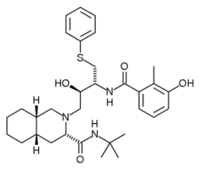A new protease inhibitor for treating HIV infection--not only in adults but children, as well--has been approved by FDA. In addition, the agency has given "pediatric use" labeling to an already approved protease inhibitor for adults.
New protease inhibitor Viracept (nelfinavir) and the previously approved Norvir (ritonavir) are some of the most powerful medicines against HIV, the virus that causes AIDS.
FDA granted the approvals March 14. Viracept's approval came about three months after FDA received the drug application. Its labeling will include a "pediatric use" statement that gives doctors specific dosage recommendations for patients 2 to 13.
"[These] actions not only add another powerful weapon to our arsenal for treating HIV infection but provide us with critical information on using these cutting edge drugs to help HIV-positive children," HHS Secretary Donna E. Shalala said.
Viracept received "accelerated" approval, a regulatory mechanism in which FDA bases early approval for a product on laboratory markers (such as plasma HIV RNA, a measure of viral load) until clinical endpoints (such as disease progression or rates of death) are available.
The drug's "pediatric use" labeling stems from a 1994 regulatory reform measure designed to ease the process of including drug label information to help doctors treat pediatric patients with serious or life-threatening diseases. Pediatric labeling information can now be included when evidence suggests that the course of the disease and effects of a drug are similar in children and adults.
In clinical studies of up to 24 weeks, the new drug was active when used alone or with other antiretroviral drugs for HIV. But because its antiviral activity is increased when used with the other drugs, combination therapy is recommended.
The most common side effect is diarrhea, which can usually be controlled with over-the-counter medicines. Other side effects include nausea, vomiting and weakness.
The drug cannot be used concurrently with several other drugs because of possible drug interactions that cause serious, potentially life-threatening irregular heartbeats or prolonged sedation. The potential drug interactions will be clearly highlighted on the package label.
Viracept is marketed by Agouron Pharmaceuticals, of La Jolla, Calif. Norvir is marketed by Abbott Laboratories, of Abbott Park, Ill.
COPYRIGHT 1997 U.S. Government Printing Office
COPYRIGHT 2004 Gale Group



